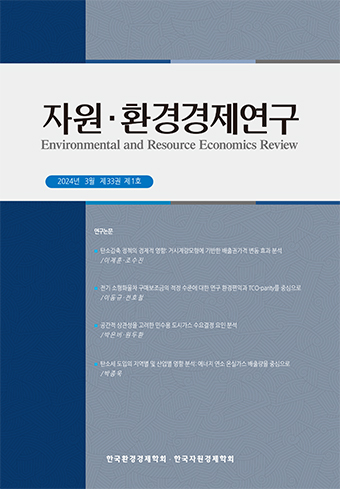Research Paper
Abstract
References
Information
This study tries to quantify the regional NIMBY costs to nuclear power plants. NIMBY costs are estimated as willingness to pays for avoiding nuclear power plants near residential areas through the contingent valuation method(CVM). In the study, it was assumed that the nuclear power plants were newly constructed around the residences. The result of 600 respondents living within a radius of 30 km of nuclear power plants compared to the result of 600 respondents living in the metropolitan area, which revealed that there were significant NIMBY costs to the construction of nuclear power plants in all residences. By region, the willingness to pay in the metropolitan area was greater than that in the nuclear power areas. This study focuses on NIMBY to nuclear power plants from a regional point of view, which can provide important information in establishing prudent and sound nuclear power policies.
본 연구는 원자력발전소에 대한 지역적인 님비(NIMBY)를 정량적으로 추정하는 것에 목적이 있다. 가상가치법을 이용하여 원자력발전소가 거주지 주변에 새롭게 건설되는 것을 가정하고, 전력 소비자들이 원자력발전소를 회피하기 위한 님비의 강도를 지불의사액(WTP)을 이용하여 측정하였다. 추정 결과 현재 원자력발전소 반경 30km 이내에 거주하는 600명의 응답자와 수도권에 거주하는 600명의 응답자 모두 원자력발전소가 인근지역에 건설되는 것을 반대하였다. 전체 응답자의 평균 지불의사액은 45.3원/KWh으로 국내 전기요금의 43%를 추가적으로 인상하더라도 원자력발전소를 회피하고자 하는 것으로 나타났다. 지역별로는 수도권지역 응답자의 지불의사액이 원전지역 응답자의 지불의사액보다 더 크게 나타났는데, 원자력발전소에 대한 님비가 수도권에서 더욱 크다는 것을 의미한다.
- 과학기술부, 「원자력발전에 대한 지역주빈들의 인식과 태도」, 성균관대학교 세베이리서치센터, 2003.
- 권오상, 「환경경제학」, 박영사, 2005.
- 김근식‧김서용, “다차원적 편익지각이 원자력수용성에 미치는 여향에 대한 실증분석”, 「행정논총」, 제55권 4호, 2017, pp. 207~245.
- 김서용‧김근식, “위험과 편익을 넘어서: 원자력발전소 수용성에 대한 경험적 감정의 휴리스틱 효과”, 「한국행정학보」, 제41권 3호, 2007, pp. 373~398.
- 박천희‧김서용, “원자력 수용성 결정에서 지식의 효과와 기능: 객관적 지식과 주관적 지식을 중심으로”, 「행정논총」, 제53권 3호, 2015, pp. 117~150.
- 오영미‧최진명‧김학수, “위험을 수반한 과학기술의 낙인효과”, 「한국언론학보」, 제52권 1호, 2008, pp. 467~500.
- 원두환, “원자력 시설 수용 선호의 이질성에 관한 연구”, 「자원환경경제연구」, 제19권 4호, 2010, pp. 853~874.
- 원두환‧김현제‧김윤경, “원자력발전 온배수 이용에 대한 소비자 보상액 추정”, 「경제연구」, 제27권 1호, 2009, pp. 189~209.
- 원자력안전위원회, 「방사선비상계획구역 이란? - 비상계획구역 바로알기」, 2015.
- 이석호, “후쿠시마 원전사고 이후 해외 원자력정책 주요 동향”, 「World Energy Market Insight」 4호, 에너지경제연구원, 2011.
- 홍사균‧최용원‧장현섭‧이영준, 「후쿠시마 원전사고 이후 원자력발전을 둘러싼 주요 쟁점과 향후 정책방향」, 과학기술정책연구원, 정책연구, 2011-23, 2011.
- Aoki, M. and G. Rothwell, “A Comparative Institutional Analysis of the Fukushima Nuclear Disaster: Lessons and Policy Implication,” Energy Policy, Vol. 53, 2013, pp. 240~247.10.1016/j.enpol.2012.10.058
- Arrow, K., R. Solow, R. Portney, E. Leamer, R. Radner, and H. Schuman, “Report for the NOAA Panel on Contingent Valuation,” Federal Register, Vol. 58, 1993.10.1108/S0573-8555(1993)0000220017
- Brown, T., and R. Gregory, “Why the WTA-WTP Disparity Matter,” Ecological Economics, Vol. 28, No. 3, 1999, pp. 323~335.10.1016/S0921-8009(98)00050-0
- Greenberg, M., “NIMBY, CLAMP, and the Location of New Nuclear-Related Facilities: U.S. National and 11 Site-Specific Surveys,” Risk Analysis, Vol. 29, 2009, pp. 1242~1254.10.1111/j.1539-6924.2009.01262.x 19572962
- Hanemann, J., B. Loomis, and J. Kanninen, “Statistical Efficiency of Double-bounded Dichotomous Choice Contingent Valuation,” American Journal of Agricultural Economics, Vol. 73, No. 4, 1991, pp. 1255~1263.10.2307/1242453
- Homma, T., and K. Akimoto, “Analysis of Japan’s Energy and Environment Strategy after the Fukushima nuclear Power plant Accident,” Energy Policy, Vol. 62, 2013, pp. 1216~1225.10.1016/j.enpol.2013.07.137
- IEA, Electricity Information, 2014.
- Jorgensen, B. and J. Syme, “Protest Responses and Willingness to Pay: Attitude Toward Paying For Stormwater Pollution Abatement,” Ecological Economics, Vol. 33, 2000, pp. 251~265.10.1016/S0921-8009(99)00145-7
- Kim, Y., W. Kim, and M. Kim, “An International Comparative Analysis of Public Acceptance of Nuclear Energy,” Energy Policy, Vol. 66, 2014, pp. 475~483.10.1016/j.enpol.2013.11.039
- Larson, E. and R. Krannich, “A Great Idea, Just Not Near Me! Understanding Public Attitudes About Renewable Energy Facilities,” Society & Natural Resources, Vol. 29, No. 12, 2016, pp. 1436~1451.10.1080/08941920.2016.1150536
- Lozano, R., M. Hernandez-Ceballos, J. Adame, M. Casas-Ruiz, M. Sorribas, E. Miguel, and J. Bolivar, “Radioactive Impact of Fukushima Accident on the Iberian Peninsula: Evolution and Plume Previous Pathway,” Environment International, Vol. 37, No. 3, 2011, pp. 1259~1264. 10.1016/j.envint.2011.06.001 21683442
- NDSL, National Digital Science Library, 「원자력 에너지: 다른 국가 사례에서 배울 점들, 과학기술정책동향」, 2008.
- Pearce, J., “Limitations of Nuclear Power as a Sustainable Energy Source,” Sustainability, Vol. 4, 2012, pp. 1173~1187.10.3390/su4061173
- Siegrist, M. and V. Visschers, “Acceptance of Nuclear Power: The Fukushima Effect,” Energy Policy, Vol. 59, 2013, pp. 112~119.10.1016/j.enpol.2012.07.051
- Srinivasan, T. and T. Gopi Rethinarag, “Fukushima and Thereafter: Reassessment of Risk of Nuclear Power, Energy Policy, Vol. 52, 2013, pp. 726~736.10.1016/j.enpol.2012.10.036
- Stoutenborough, J., S. Sturgess, and A. Vedlitz, “Knowledge, Risk and Policy Support: Public Perceptions of Nuclear Power,” Energy Policy, Vol. 62, 2013, pp. 176~184.10.1016/j.enpol.2013.06.098
- Sun, C., N. Lyu, and X. Ouyang, “Chinese Public Willingness to Pay to Avoid Having Nuclear Power Plants in the Neighborhood, Sustainability, Vol. 6, 2014, pp. 7197~7223. 10.3390/su6107197
- van der Horst, D., “NIMBY or not? Exploring the Relevance of Location and the Politics of Voiced Opinions in Renewable Energy Siting Controversies,” Energy Policy, Vol. 35, 2007, pp. 2705~2714.10.1016/j.enpol.2006.12.012
- Woo, J., H. Moon, J. Lee, and J. Jang, “Public Attitudes Toward the Construction of New Power Plants in South Korea,” Energy & Environment, Vol. 28, No. 4, 2017, pp. 499~517. 10.1177/0958305X17705948
- World Nuclear Association, http://www.world-nuclear.org , 2019년 3월 20일 접속, 2019.
- Zhang, L. and X. Tong, “Analysis of Public NIMBY Attitude and Its Factors,” Social Science Research, Vol. 1, 2014, pp. 105~111.
- Publisher :Environmental and Resource Economics Review
- Publisher(Ko) :자원 · 환경경제연구
- Journal Title :자원·환경경제연구
- Journal Title(Ko) :Environmental and Resource Economics Review
- Volume : 28
- No :4
- Pages :557~581
- DOI :https://doi.org/10.15266/KEREA.2019.28.4.557



 자원·환경경제연구
자원·환경경제연구






